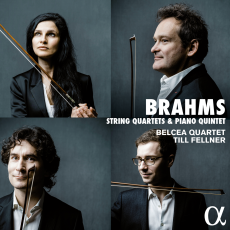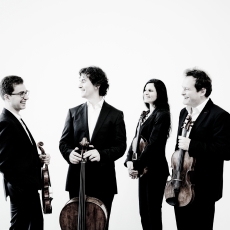Belcea Quartet - Brahms: String Quartets & Piano Quintet - Gramophone
In 2003 the Belcea Quartet recorded a nerves-on-a-knife’s-edge account of Brahms’s C minor Quartet (Op 51 No 1) for EMI. Here, more than a decade on, their conception retains its essential ferocity, though without quite so much exhausting franticness. Brahms’s score has so much agitation written right into it – jagged melodic contours, motivic obsessiveness and gasping down-beats – that pushing hard is less effective than merely pulling taut. The fractionally broader perspective presented on this new Alpha recording is more satisfying, not only in its elucidation of detail – listen, for example, to the weight of the marcato passages in the first movement, beginning at 6'02" – but also in conveying warm affection. The slow movement is considerably more compelling here as a result, with enhanced sensitivity to harmonic subtleties.
In some respects, the Belcea’s interpretation of Op 51 No 2 is more impressive still, carefully balancing rigour and spontaneity. Indeed, the musicians are often daringly free with tempo but to eloquent effect. Note the way they lean yearningly into the long notes of the first movement’s second theme, or to the passionate impulsivity of the Andante moderato. What a surprise, then, that the opening Vivace of Op 67 sounds so rhythmically and emotionally strait-laced; there’s none of the playful exuberance one hears in the Takács Quartet’s recording, for instance. Happily, the remaining movements find the Belcea back in form, and the final two movements are particularly engaging in their blend of sweetness and melancholy.
The Piano Quintet is, in many respects, exquisitely realised, with lovely chiaroscuro shadings and a rhythmic incisiveness that’s particularly effective in the Scherzo and finale. Indeed, the Scherzo is almost terrifying in its relentlessness, the dotted rhythms hammered out like morse code. Till Fellner and the quartet take considerable care over voicing, so that even thick textures have clarity. And, in the finale, they are among the few performers who observe Brahms’s instruction that the minim of the Poco sostenuto introduction and the crotchet of the Allegro non troppo be in the same tempo.
What’s missing here is the kind of lyrical abandon one hears in the A minor Quartet. It’s scrupulously musical but lacks the impetuousity of Hough and the Takács, as well as – in the slow movement – the rapt tenderness of Eschenbach and the Amadeus (DG). Those caveats aside, this new set offers sufficient insight and delight to be worthy of any devoted Brahmsian’s attention.

